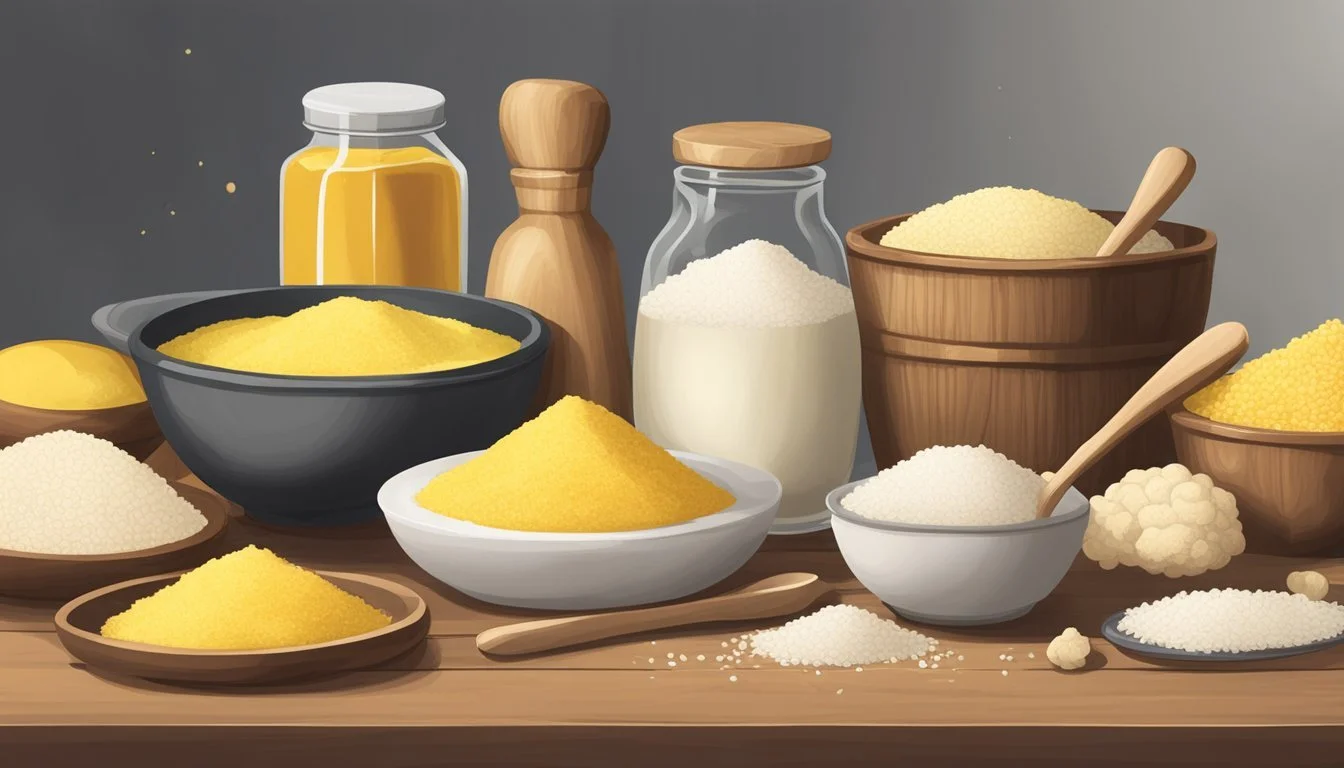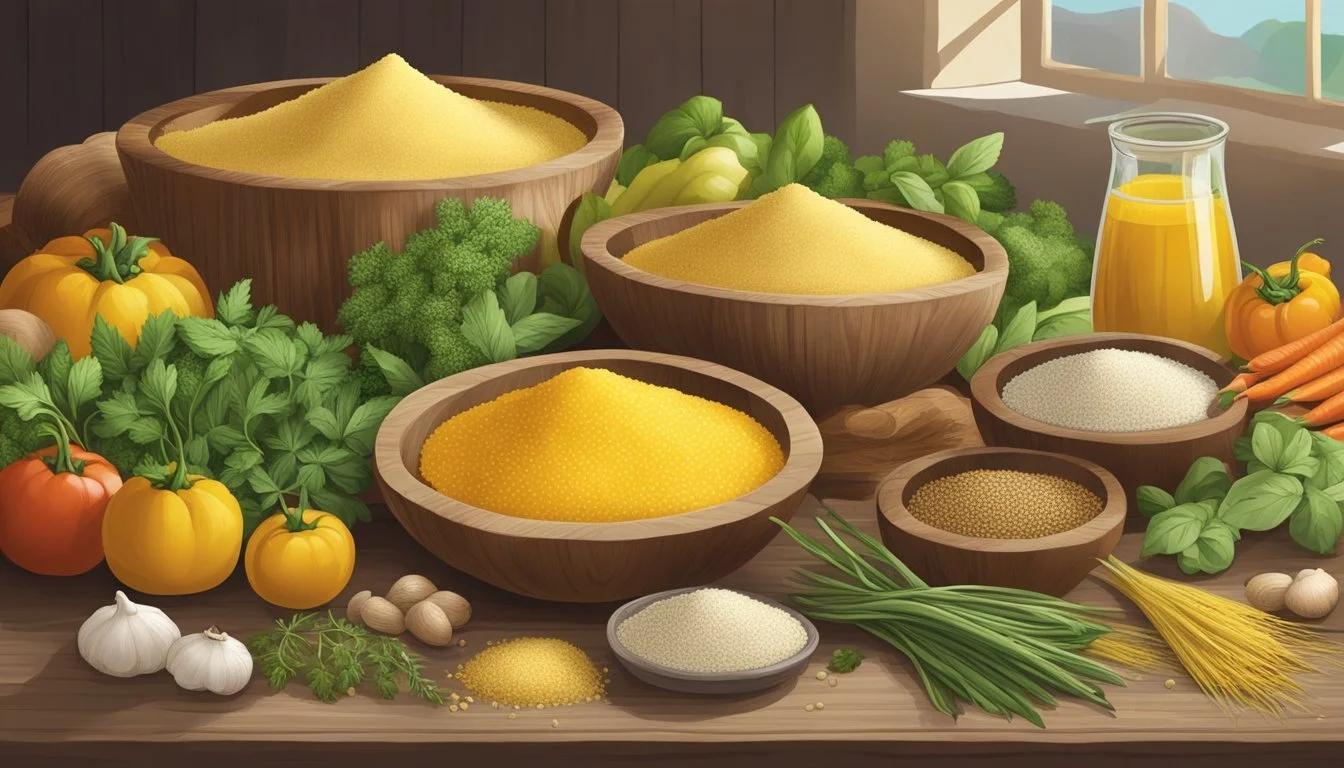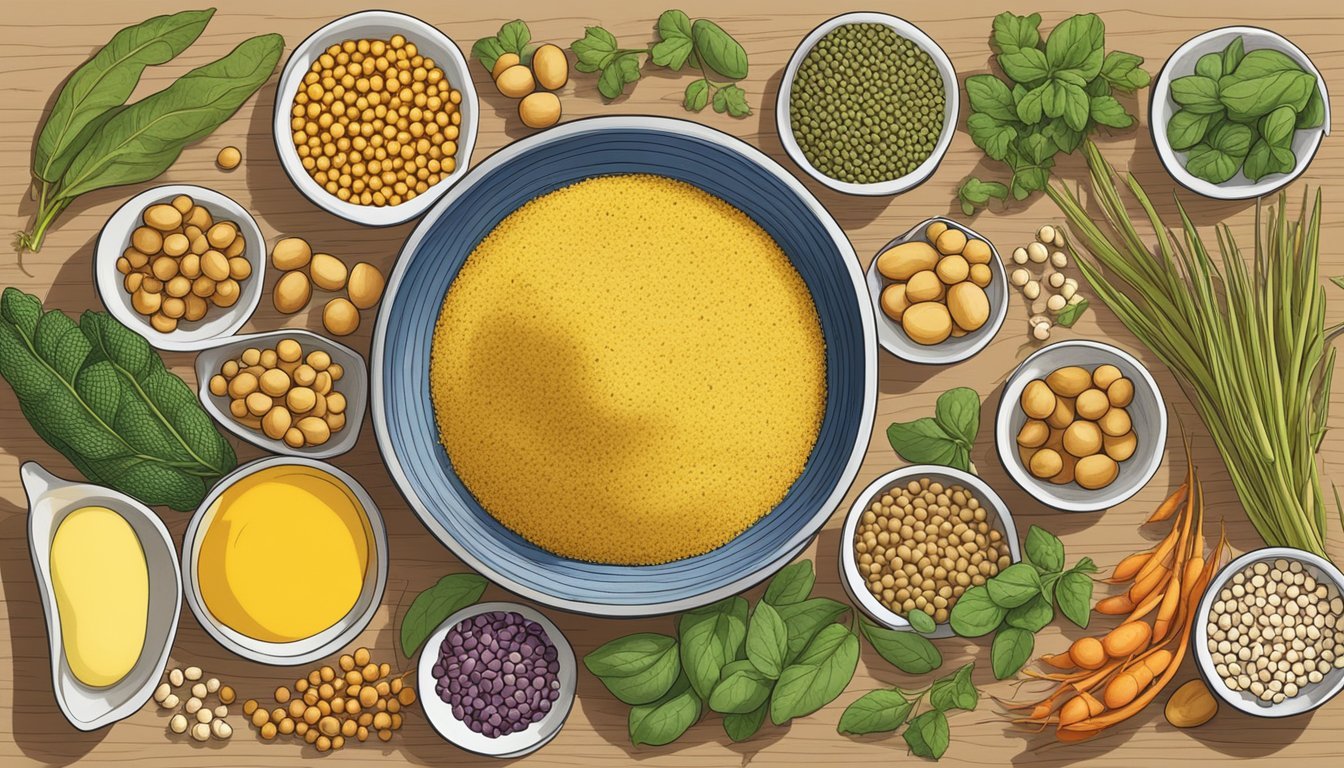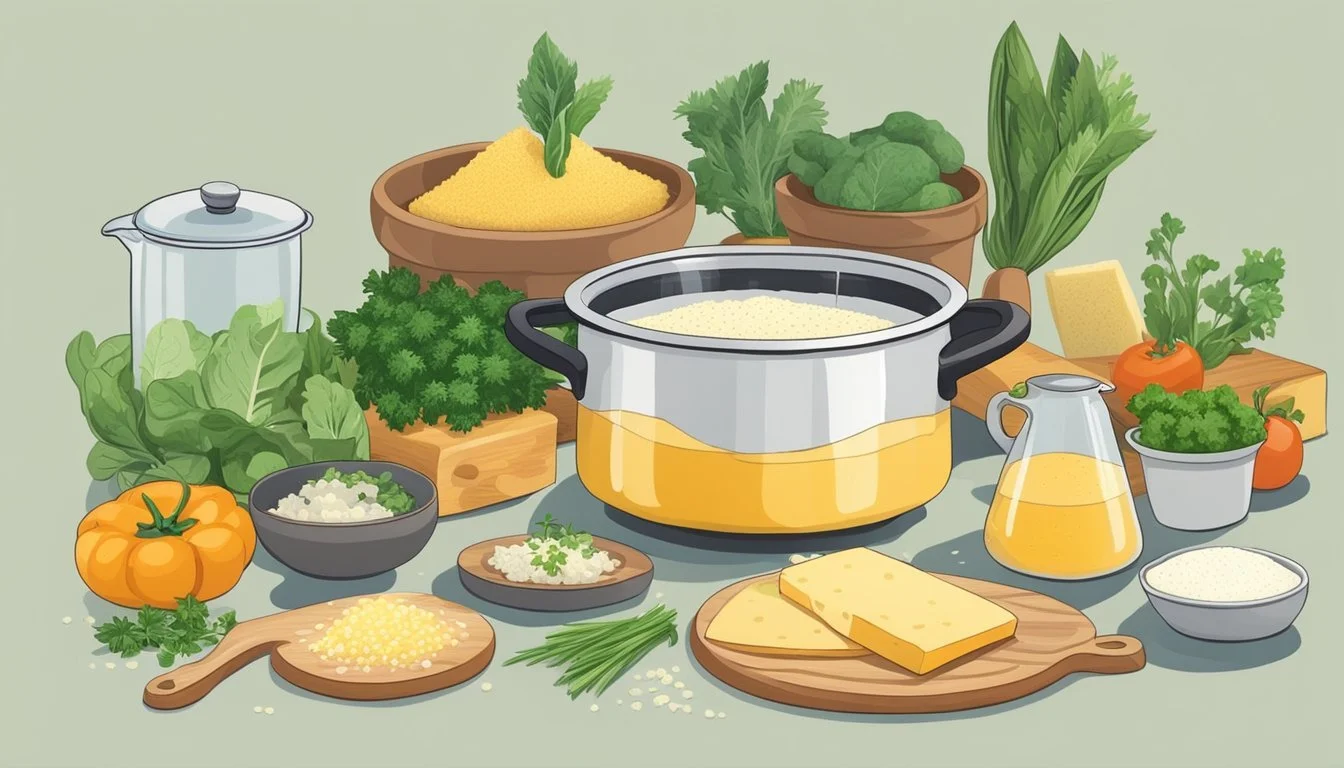Polenta Substitutes
Top Alternatives for Your Recipes
Polenta, a staple of Italian cuisine, is a versatile dish made from cornmeal that has been a cherished part of meals for centuries. Traditionally, it is served either creamy or allowed to cool and solidify into a loaf that can be baked, fried, or grilled. This gluten-free dish can be a base for numerous toppings and sauces, making it a beloved comfort food for many who enjoy its simple, yet rich, texture and flavor.
However, there are situations when polenta is not readily available or when dietary preferences call for an alternative. Finding an adequate substitute that closely mimics the taste and texture of polenta can be a challenge. To ease this culinary predicament, various alternatives can be employed. These substitutes include items such as rice, cauliflower puree, and even grits – a food that shares corn as its primary ingredient. Each alternative brings its unique qualities while striving to provide the familiar polenta experience.
When selecting a substitute for polenta, it's essential to consider the desired outcome since the texture and flavor can vary. Options like corn grits offer a similar coarseness and can be prepared with additional liquids such as broth or milk to achieve a creamy consistency. On the other hand, pureed cauliflower presents a lighter option that can mimic the texture of soft-cooked polenta while also serving as a lower-carb alternative. Meanwhile, the likes of rice, when used correctly, can absorb flavors well and provide a satisfying, though different, base for traditional polenta pairings.
Understanding Polenta
Polenta is a traditional dish in Italian cuisine with its roots firmly planted in Northern Italy. Traditionally, it is made from cornmeal, which is boiled in water, milk, or broth, until it reaches a creamy consistency. Over time, polenta has transformed from a 'peasant food' into a versatile component enjoyed in various gastronomic settings.
The basic preparation involves stirring cornmeal into hot liquid and cooking it over low heat. Here, patience is key, as the mixture thickens and the flavors develop. The result can be served in various ways: soft and creamy, or allowed to cool and solidify, then sliced and grilled, baked, or fried.
The corn used for polenta is typically a flint variety, known for its hard, starchy kernel. This hard corn yields a better texture and consistency compared to the sweet corn eaten on the cob. Polenta's flavor profile is subtly sweet and earthy, providing a neutral base that partners well with rich sauces, roasted meats, and vegetables.
Here’s a simple comparison of polenta’s preparation styles across various Italian regions:
Region Preparation Style Northern Creamy, often paired with meats Central Fried or grilled, served as slabs Southern Mixed with cheeses or sauces
Each region in Italy often puts a local spin on the dish, using ingredients that are readily available and aligning with regional tastes. Regardless of how it's served, polenta remains a staple of the Italian diet and a testament to the versatility of corn in cooking.
Primary Polenta Substitutes
When one is in need of a polenta substitute, several options are available that can fit a variety of recipes and dietary needs. Polenta, a dish traditionally made from boiled cornmeal, has a distinct texture and taste that can be mimicked by similar grain-based products.
Cornmeal is the most direct substitute, as it is essentially the same product as polenta but often milled to a different coarseness. It can be cooked to reach a similar consistency and flavor profile.
Grits come from the same family as polenta, as they are also made from ground corn. The primary difference lies in the type of corn used and the granularity of the grind. One can prepare grits to a creamy texture akin to that of soft polenta.
Corn Flour: Though finer in texture, corn flour can be used in cooking similar to cornmeal, providing a smoother consistency but less robust texture.
Cream of Wheat: Another alternative is Cream of Wheat, a brand name for a farina-based porridge which creates a fairly similar end product to polenta when prepared; however, it lacks the corn flavor, offering a mild taste.
Here are substitutes one might consider:
Substitute Characteristics Best Used In Cornmeal Varied granularity, corn-based Soft polenta, Baked dishes Grits Similar to cornmeal, may be white or yellow corn Creamy dishes, Porridges Corn Flour Fine texture, corn-based Baking, Delicate sauces Cream of Wheat Wheat-based, fine texture Sweet dishes, Breakfast porridge
Grain-Based Alternatives
When looking for grain-based substitutes for polenta, one must consider the texture, cooking properties, and nutrient content of the alternatives. Grains like rice and couscous can deliver a similarly satisfying mouthfeel, while quinoa and barley provide an exceptional source of dietary fiber and complex carbohydrates.
Rice and Risotto
Arborio rice, a staple in making creamy risotto, is a common substitute offering a texture comparable to polenta. To construct a dish akin to soft polenta, one could prepare a creamy risotto incorporating chicken or vegetable broth to enhance the flavor. This substitute not only mirrors the consistency of polenta but also provides magnesium and iron.
Quinoa and Couscous
Both quinoa and couscous can serve as a polenta replacement. Quinoa, with its nutty flavor, adds a complete protein profile to dishes and is rich in dietary fiber and iron. Couscous, known for its mild flavor, adapts well to a variety of flavor profiles and, although it generally possesses a finer texture, it can mimic the granularity of cooked polenta when properly prepared.
Barley and Oatmeal
Barley offers a chewy texture and is a hearty option for incorporating new flavors into traditional polenta recipes. Its high fiber content supports digestive health. Oatmeal, commonly enjoyed as a hot porridge, can mirror the creamy aspect of polenta when cooked with a sufficient amount of liquid while providing a substantial amount of complex carbohydrates.
Buckwheat and Millet
Buckwheat and millet broaden the spectrum of textures and flavors for those exploring polenta alternatives. Buckwheat has a distinctive, earthy taste and is gluten-free, making it suitable for those with sensitivities. Millet, frequently used in various cultural cuisines, has a mild, slightly nutty taste and offers versatility in cooking, much like polenta. Both grains contribute valuable nutrients like magnesium and lend themselves to creative culinary endeavors.
Vegetable-Based Substitutes
For individuals seeking healthier alternatives to traditional polenta due to dietary restrictions or a desire for a low-carb option, vegetable-based substitutes provide a suitable and delicious solution. These substitutes often replicate the creamy texture characteristic of polenta, while also catering to those looking for gluten-free options.
Cauliflower Mash
Cauliflower mash is a superb and versatile stand-in for polenta. Boasting a creamy consistency, cauliflower mash works well for those on a gluten-free or low-carb diet. Here's a simple comparison:
Polenta Cauliflower Mash Grain-based Vegetable-based Higher in Carbs Lower in Carbs Gluten-present Gluten-free
One prepares it by steaming or boiling cauliflower until it's tender, then mashing it until it reaches a smooth, polenta-like texture. For added flavor, one might incorporate butter, cheese, or herbs.
Mashed Potatoes and Purees
Mashed potatoes are another vegetable-based substitute that can take the place of polenta in a dish. While they do offer a similar creamy texture, they are higher in carbs compared to cauliflower options.
Polenta Mashed Potatoes Corn-based Potato-based Traditional taste Familiar creaminess
For those looking to keep the carb count closer to that of cauliflower, pureed root vegetables such as turnips or rutabagas provide a hearty alternative. They can be cooked and blended to achieve a creamy consistency that mimics polenta, suitable for those managing dietary restrictions.
Root Vegetable Alternatives
Root vegetables offer a nutritious and flavorful substitute for polenta. They cater to various dietary restrictions and can present a low-carb alternative, maintaining the soft and tender texture that is often desired in traditional polenta dishes.
Sweet Potatoes
Sweet potatoes are an excellent choice for replacing polenta due to their tender texture and slightly sweet flavor. When prepared as mashed sweet potatoes, they provide a creamy consistency that resembles the smoothness of polenta. To prepare:
Boil or steam peeled sweet potatoes until tender.
Mash with butter, plant-based milk, or broth to achieve the desired creaminess.
Season with salt and pepper to taste.
Pumpkin Puree
For a substitute that is both low-carb and fitting for those with dietary restrictions, pumpkin puree stands out. With its gently sweet profile, it makes for a comforting alternative to polenta. The process involves:
Choosing a cooking pumpkin such as sugar pie, peeling, and cutting it into chunks.
Boiling until the pumpkin is soft.
Pureeing the tender pumpkin to create a smooth mashed pumpkin texture.
Both sweet potatoes and pumpkin puree can be easily seasoned to complement the main dish, much like polenta, and serve as a side or a base for a plethora of recipes.
Legume-Based Alternatives
When seeking alternatives to polenta that derive from legumes, one should consider the textural properties and the subsequent impact on the dish's creaminess. Legumes are an inclusive category; however, not all are suitable replacements in terms of texture for polenta.
One can opt for chickpea flour, also known as gram flour or besan, recognized for its dense, hearty consistency. When cooked with water or broth, it can mimic the creaminess expected of polenta. The ratio for substitution should remain equal: substitute a cup of polenta with a cup of chickpea flour.
Similarly, lentils can serve as a base. Mashed or pureed cooked lentils, particularly red or yellow varieties, deliver a creamy texture compatible with polenta-based dishes.
Here’s a quick reference for using legume-based alternatives:
Legume Preparation Suggested Use Chickpea Flour Cook with water or broth Equivalent to polenta for savory bases Lentil Puree Boil and puree lentils Thicken soups, stews, or as a creamy base
It's imperative to season these alternatives well, as legumes can carry a distinct flavor profile compared to polenta's mild and versatile taste. Additionally, one must be mindful of cooking times as legumes differ in this regard, often requiring more prolonged cooking to achieve a desirable consistency.
Cooking Techniques for Substitutes
When preparing substitutes for polenta, various cooking techniques can be employed to achieve a texture and color reminiscent of the original dish.
For Grits:
Bake: Grits can be baked after boiling to create a firmer, crusty top.
Grill: Before grilling, allow boiled grits to set, then slice them.
Fry: Grits can be fried into cakes for a crispy exterior with a smoother center.
For Mashed Potatoes:
Texture: To mimic polenta, one can adjust the creaminess by reducing the added liquid for a firmer texture.
Color: A golden crust can be achieved by baking or pan-frying the mashed potatoes.
For Semolina:
Boil: Cook until desired consistency, similar to polenta, for smoother texture.
Bake/Fry: To create firmer textures and add color, one may bake or fry cooked semolina dough.
For Cauliflower (Low-Carb Option):
Process: Cauliflower should be processed into rice-like consistency.
Cook: Gentle cooking with frequent stirring can yield a smooth texture. Season well to enhance flavor.
Each substitute offers a unique texture and the method of cooking alters the end result. It's vital to consider how each technique—baking, grilling, and frying—affects the firmness or smoothness required in the dish. By tailoring these methods, cooks can adapt these substitutes to closely resemble polenta's versatility and satisfaction.
Incorporating Substitutes in Recipes
When adapting recipes to accommodate a polenta substitute, one must consider the substitute's properties—like texture, flavor, and moisture absorption. Each alternative offers unique qualities that may enrich a recipe or require slight adjustments to achieve the desired outcome.
Rice is a common substitute, especially in a pudding or casserole, where its absorbency makes it swell considerably. For every cup of polenta, half a cup of rice is typically sufficient. Still, chefs may adjust proportions based on the rice variety.
Masa harina, a staple in Latin American cuisine, can replace polenta to infuse a Mexican flavor into dishes. It functions particularly well in recipes like bread where a fine, corn-based flour is desired.
Corn grits mirror polenta's texture and taste most closely, making them an ideal one-to-one substitute. Grits can form the backbone of a dish much like polenta, whether it's a smooth breakfast porridge or a robust dinner base.
Semolina and mashed potatoes also serve as fine replacements, each bringing a distinctive texture and flavor profile to a dish. They work well as bases for toppings or mixed into casseroles for added body.
Here's a simple guide for substitution ratios:
Substitute Ratio Best Used For Rice 1 cup polenta : 1/2 cup Puddings, casseroles Masa Harina 1:1 Breads, tortillas Corn Grits 1:1 Porridge, bases Semolina 1:1 Breads, pastries Mashed Potatoes 1:1 Bases, fillings
Remember that polenta is a versatile ingredient, so while substitutes can mimic its role in many recipes, each brings its own character to the dish and may slightly alter the final flavor and texture. When incorporating substitutes, chefs should taste and adjust seasonings as necessary to achieve harmony within the recipe.
Dietary Considerations
When exploring substitutes for polenta, it's crucial to consider dietary restrictions such as the need for gluten-free or low-carb options and managing any potential allergies.
Low-Carb and Gluten-Free Options
For individuals adhering to a low-carb diet, cauliflower stands out as a nutritious substitute. When grated or processed, it achieves a rice-like texture which, once cooked, can mimic polenta's consistency. This alternative is not only low in carbohydrates but also adds vital vitamins and minerals to one's diet.
Cauliflower "Polenta": Grated cauliflower cooked to a creamy texture.
Calories: Significantly lower compared to traditional polenta.
Nutrition Bonus: Rich in vitamins C, K, and B vitamins.
Gluten-free substitutes are essential for those with gluten intolerance or celiac disease. Cornmeal, the traditional base for polenta, is naturally gluten-free, but it's crucial to check for cross-contamination if gluten is a concern.
Certified Gluten-Free Cornmeal: Ensures no cross-contamination.
Beans and Lentils: Pureed or mashed, these can offer a similar consistency with protein benefits.
Managing Allergies
For those with corn allergies, alternative grains need to be considered. Grains like quinoa or buckwheat can be ground and prepared in a polenta-like fashion.
Quinoa and Buckwheat: Finely ground to use in place of cornmeal.
Cooking Methods: Simmer with water or broth until a thick, creamy consistency is reached.
By carefully selecting substitutes and verifying production practices, individuals can enjoy polenta-like dishes that adhere to their dietary restrictions and preferences.
Nutritional Information
When considering substitutes for polenta, it is important to regard their nutritional content, chiefly focusing on dietary fiber, caloric value, magnesium, and carbohydrates.
Grits, a common substitute, approximately provide 182 calories per cup. They are a good source of carbohydrates, with 38 grams per serving, and contain about 2 grams of dietary fiber. Grits are also a source of magnesium.
Mashed potatoes offer a different nutritional profile with roughly 214 calories per cup. They are higher in carbohydrates, accounting for 35 grams, and provide 3 grams of dietary fiber. Potatoes are naturally rich in magnesium as well.
Semolina flour stands out for its carbohydrate content, with close to 122 grams per cup, contributing to its higher calorie count of 601 calories. It provides a modest 7 grams of dietary fiber and is an excellent source of magnesium.
Rice, particularly brown rice, is frequently mentioned as a substitute. It contains about 218 calories per cup, with 45 grams of carbohydrates. It is higher in dietary fiber, offering about 4 grams, and is a good source of magnesium.
Cauliflower, representing a low-carb alternative, contains approximately 27 calories per cup when raw. It is low in carbohydrates with 5 grams and high in dietary fiber, providing 2 grams per cup. Cauliflower also contributes a modest amount of magnesium.
It should be noted each substitute has its own unique nutritional profile. One's choice may depend on dietary goals, whether they are looking to increase fiber intake, reduce calories, or manage carbohydrate consumption.
Final Thoughts
When seeking polenta substitutes, one has the opportunity to explore a range of alternative ingredients that can infuse new flavors into their meals. Corn grits are a close substitute, offering a similar texture and flavor profile. They are particularly effective when cooked with a combination of broth and milk, and enriched with butter and cheese.
For those looking for a different taste or for dietary reasons, mashed potatoes, semolina flour, or even cauliflower can serve as substitutes. Mashed potatoes provide a creamy consistency, while semolina flour, which is wheat-based, offers a more grainy texture. Cauliflower, when grated, can mimic the texture of cooked polenta and is ideal for a low-carb option.
Here's a succinct comparison:
Substitute Texture Flavor Profile Dietary Note Corn Grits Similar Comparable Gluten-free Mashed Potatoes Creamy Mild Gluten-free Semolina Flour Grainy Wheaty Contains gluten Cauliflower Rice-like Neutral Low-carb, gluten-free
Polenta's status as a versatile ingredient allows it to be replaced by these alternatives without compromising the integrity of the dish. Chefs and home cooks can confidently use these substitutes and expect to achieve a pleasant culinary experience.
Substituting polenta does not merely imitate the original; it can enhance a dish by introducing new flavors and textures. Each substitute brings its unique properties to the table, opening up a spectrum of possibilities for creative cooking.









